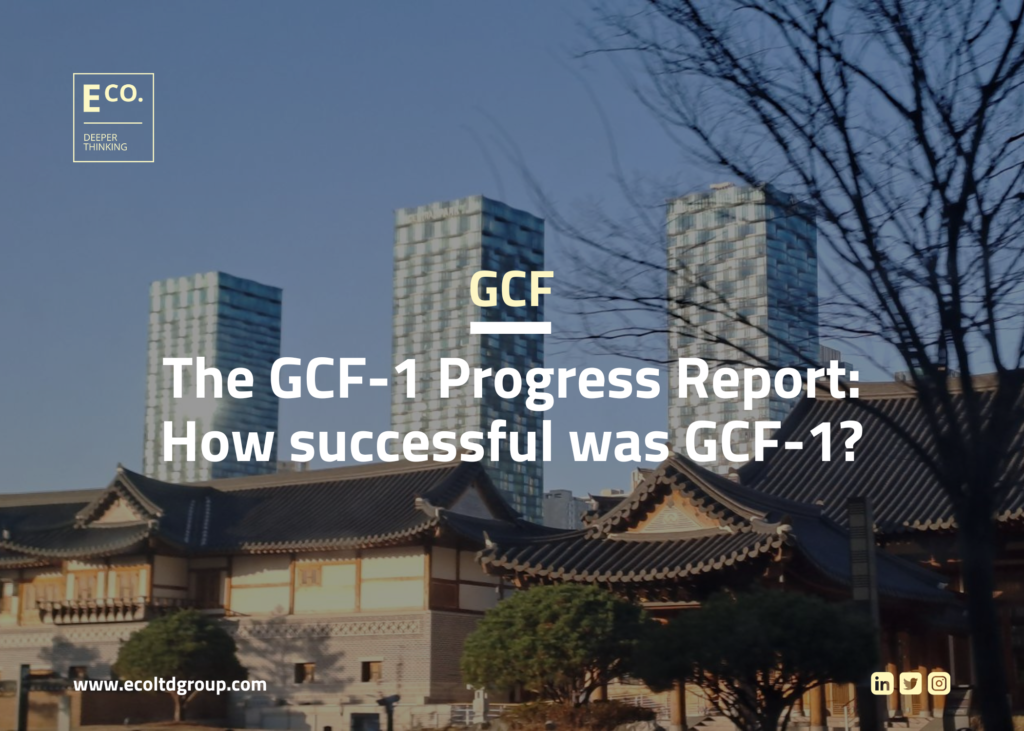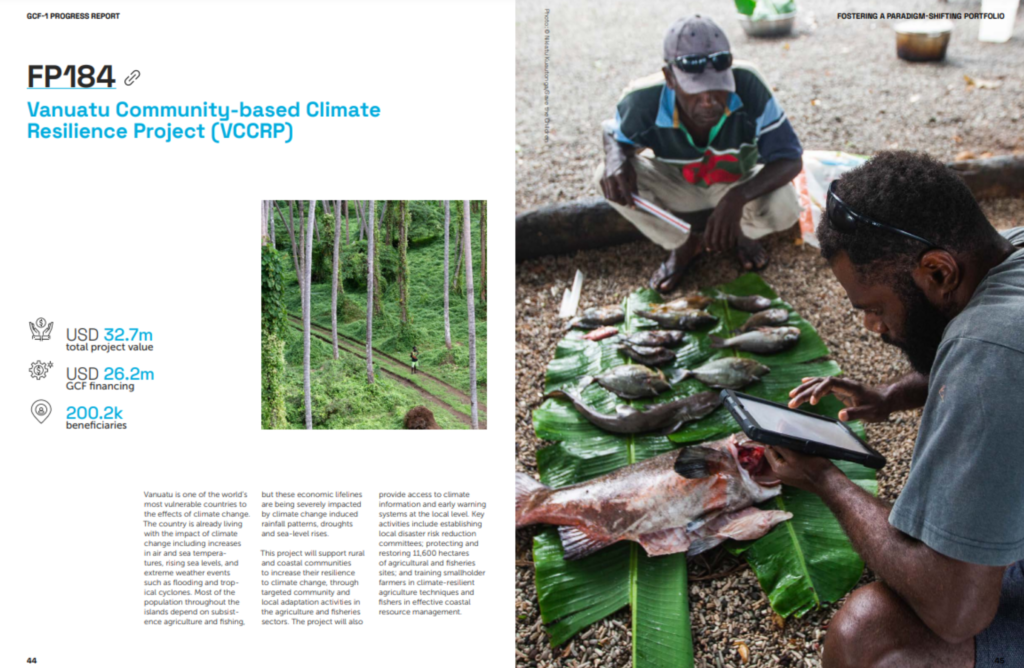The GCF-1 Progress Report: How successful was GCF-1?
15 May 2023, Category: All insights, News, Tags: climate finance, gcf, GCF insight, GCF-1, GCF-1 Progress Report, Green Climate Fund

The Green Climate Fund has recently released the GCF-1 Progress Report. So why is this significant?
The GCF-1 Progress Report is significant for several reasons. First of all, it provides insight on the organisational growth of the GCF over the last four years, covering the time of the GCF’s first replenishment (GCF-1). Over these years, we’ve seen the GCF’s approach alter, from one that simply channels climate finance, to one that incentivises increased volumes of finance, finance that comes from both private and public sources.
At the time of writing, the GCF manages 216 projects that are worth around USD 12 billion. If we include co-financing, that number rises to a total of USD 42.8 billion managed by the GCF (as of 2022). So what does the GCF-1 Progress Report tell us about the current state of the GCF?
- There have been several positive advances in the strategic development of the GCF over this period.
- A number of key milestones have been reached, such as the mobilisation of USD 42.8 billion.
- There are still areas to improve, such as ‘clarifying operational priorities’ and developing a ‘strategic approach to partnership’.
- The report does not include what could be argued as ‘the whole picture’, so insight from independent sources is also needed to paint a clear picture.
Key insights from GCF-1
Inside the report, it reveals multiple key insights that highlight the progress of GCF-1 in comparison to earlier periods:
- The GCF is spearheading four operational areas: accelerating innovation through investment in startups and new climate solutions; Developing integrated climate strategies with a focus on readiness; De-risking projects to crowd-in finance from risk-averse public and private organisations; Greening the financial sector.
- GCF-1 has seen the organisation increase access to climate finance in several ways, such as streamlining the funding process through programming guidance and assessment tools that help ease the application process, and enhancing direct access through de-centralised grants of up to USD 25 million and increasing the share of programming channelled via direct access entities.
- We can see a more proactive approach to programming support, as the GCF began giving direct support to project design and structuring.
- There’s been a direct emphasis on catalysing private sector interest and support, as part of the need to diversify the financial flows being received.
- Another focus has been capacity building and country ownership, with the GCF improving the capabilities of their Readiness Programme and their Project Preparation Facility (PPF).
GCF-1 progression
Alongside the recording of strategic progress, the Report also highlights some key milestones that the GCF has reached:
- The total value of approved projects over this time period was USD 25 billion, representing 88 projects. That value has grown to USD 42.8 billion, with most of that funding originating from co-financing sources.
- GCF-1 saw the GCF portfolio more than double in size since the previous period.
- In 2022, 87% of total projects had reached the implementation stage.
- To date, 63 MtCO2e of reduced emissions has been delivered by GCF projects, benefitting 57 million people directly and indirectly.
One particular point of interest is the catalysing of the private sector, an area with massive funding potential. While there are several challenges involved in mobilising the private sector, which we’ve explored in one of our past GCF insight reports, the GCF have seen positive progress. In 2022, their Private Sector Facility (PSF) portfolio had grown by USD 530 million, encompassing six funding proposals and just over a third of the total 11.4 billion making up the GCF portfolio at the time.
However, there are still obstacles for the private sector when it comes to Fund access. Smaller private organisations often are unable to see returns on investment within projects, especially if said project is based in a new or unproven market, or within areas not typically popular for investment. Similarly, said areas often suffer from a lack of effective governance or climate planning, alongside a lack of universal metrics for defining success. A role we may see the GCF increasingly pivot towards in the future is the remediation of these issues to attract more private investment.
Project focus: Vanuatu community-based climate resilience project (VCCRP)
In the GCF-1 Progress Report, it features several projects approved in 2022. One of particular interest is FP184 Vanuatu community-based climate resilience project (VCCRP). We’re proud to see this project included, as a team of E Co. consultants were instrumental within the design phase of FP184.

Image credit: Green Climate Fund
You can explore our case study on this project here.
Evaluating the GCF’s progress
It is important to note that the GCF-1 Progress Report should not be read as a siloed document. An adequate review of the GCF’s progress should be done through the evaluation of several reports. For example, recently the GCF’s Independent Evaluation Unit released their ‘Final report of the Second Performance Review of the Green Climate Fund’.
This report evaluates the overall performance of the GCF, analysing the effectiveness and efficiency of the funded activities. It is useful in its critical analysis of the GCF’s work, especially in relation to strategic directions:
As the GCF considers updates to its strategic plan for GCF-2, it finds itself at a crossroads in its strategic development. The Board has an opportunity to set clearer strategic direction and provide focus through the next USP that can clarify operational priorities and the operating model. If unaddressed, many of the current strategic and operational tensions and challenges may threaten the reputation and impact of the GCF, but they also present pivotal opportunities for the Fund to define its path forward in GCF-2. [1]
The report goes on to state, in terms of the GCF’s current position within the climate finance sector, that:
The GCF has a privileged position within the climate finance landscape, by virtue of its size and status under the UNFCCC, and it sits at the hub of a global partnership network. However, the Fund has not yet developed a strategic approach to partnership that (a) more broadly considers NDA, AEs, delivery partners (DPs), civil society and the private sector and (b) mobilizes its network towards achieving strategic and coordinated programming opportunities. [2]
What’s next for the GCF?
As GCF-1 is coming to an end, GCF-2 is about to begin, with rounds of new replenishment funding currently coming in. At the moment:
- Germany have pledged EUR 2 billion;
- Austria has pledged EUR 160 million;
- The US has pledged USD 1 billion.
Pledges by countries are critical for the continued functioning of the GCF, with GCF-2 representing the 2024-27 period – an incredibly crucial time within the fight against climate change. While pledges seem to be increasing in size, there is still an emphasis on the need to scale up climate finance to further aid climate vulnerable communities and countries.
The strategic plan for the 2024-27 period is still in the works, and will be informed by the lessons learned over the last four years and the feedback provided by both internal and external stakeholders, such as the GCF’s Independent Evaluation Unit.
However, there are still challenges to face. Several independent studies have cited a number of issues that need to be addressed going forward. For example:
- The GCF must ensure that ‘Accredited Entities have capacity to develop and deliver projects that deliver adaptation finance to the local level’[3];
- The GCF should consider adopting a ‘unified framework for local delivery of adaptation finance that emphasises local actors’ leadership in design, implementation, and management of adaptation projects’[4];
- The GCF must account for countries with low institutional capacity for developing and submitting proposals. For example, Oxfam found that, from the years 2017-18, only 20% of finance went towards LDCs, and only around 30% went to SIDs. [5]

Searching for insight on how to develop fit-for-purpose adaptation projects?
The development of successful adaptation projects around the globe that account for local context and ensure the needs of local communities are met is a difficult task. If you’re looking for support on a project, get in touch with one of our experienced consultants, or explore what we can do.
You can email us at: amy@ecoltdgroup.com
You can also follow us through our social media accounts:
Twitter: @ecoltdnews
LinkedIn: E Co.
Instagram: @ecoltdnews
References
- Independent Evaluation Unit (2023). Second Performance Review of the Green Climate Fund. Evaluation report No. 13 (February). Songdo, South Korea: Independent Evaluation Unit, Green Climate Fund. Available at <https://ieu.greenclimate.fund/sites/default/files/document/230331-spr-final-report-top-web-isbn.pdf>
- ibid.
- Omukiti, et al. 2022, The green climate fund and its shortcomings in local delivery of adaptation finance. Available at: <https://www.tandfonline.com/doi/full/10.1080/14693062.2022.2093152>
- Ibid.
- Oxfam, 2020. Climate Finance Shadow Report 2020. Available at: <https://oxfamilibrary.openrepository.com/bitstream/handle/10546/621066/bp-climate-finance-shadow-report-2020-201020-en.pdf>
Join the conversation by posting a comment below. You can either use your social account, by clicking on the corresponding icons or simply fill in the form below. All comments are moderated.